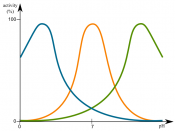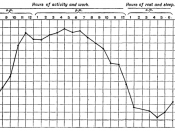Characteristics of enzymes:
"XAre made up of proteins
"XAre catalysts, as they speed up the rate of chemical reactions.
"XRemain unchanged at the end of the reaction.
"XAre needed in only small amounts.
"XAre highly specific: one enzyme catalyses one type of reaction.
"XWork best under certain optimum conditions of temperature and pH.
Role of enzymes:
Enzymes are organic catalysts. A catalysts is a general term for any substance that speeds up or brings about a chemical change without itself being used up in the reaction.
They control all the chemical processes of living systems. Enzymes are produced within living cells. Most metabolic processes would not occur at an efficient rate without enzymes. An efficient rate of metabolism is necessary for life processes to occur.
A model for enzyme specificity:
The effect of temperature, pH and substrate concentrations on enzyme activity
Temperature --- Enzymes each have an optimum temperature for activity.
Enzymes can be destroyed by high temperatures.
pH --- pH is a way of describing the acidity of a substance. Changing pH from the optimum reduces the enzyme's activity.
Substrate concentration --- substrate concentration means the amount of compound present that the enzyme catalyses. Beyond certain substrate concentrations, the rate of reaction is limited by the amount of enzyme.
First hand investigations:
Temperature - the experiment into the effect of temperature on the digestion of protein (cooked egg white) by the digestive enzyme pepsin.
If the enzyme pepsin has acted on the protein, the cooked egg white becomes a clear liquid.
Placing 4 test tubes in beakers of water at different temperatures - 0.c, 37.c, 50.c, 100.c. Shake each test tube from time to time. Observe that only the egg white with the temperature 37.c has become a clear liquid.
Homeostasis = staying the same
Is the...


